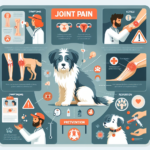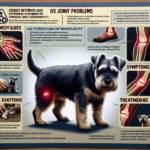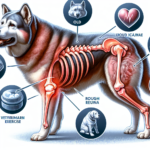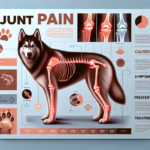American Bulldog Joint Pain: Causes, Symptoms, Prevention, and Treatment
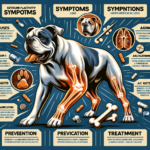
Introduction
The American Bulldog is a robust and muscular breed known for its loyalty, strength, and protective nature. Originating from the working dogs brought to America by early settlers, the American Bulldog was primarily used for farm work, including guarding livestock and property. This breed is characterized by its strong build, broad head, and powerful jaws. Despite their tough exterior, American Bulldogs are known to be affectionate and gentle with their families.
Like many large breeds, American Bulldogs are prone to certain health issues, with joint pain being a significant concern. Joint health is crucial for maintaining the mobility and quality of life of these active dogs. Understanding the causes, symptoms, prevention, and treatment of joint pain in American Bulldogs can help owners ensure their pets lead healthy and comfortable lives.
Breed-Specific Joint Pain Risks
Genetic Predisposition
American Bulldogs are genetically predisposed to several joint-related issues, including hip dysplasia, elbow dysplasia, and arthritis. Hip dysplasia is a condition where the hip joint does not fit properly into the hip socket, leading to pain and mobility issues. Elbow dysplasia involves abnormal development of the elbow joint, causing lameness and discomfort. Arthritis, a degenerative joint disease, can also affect American Bulldogs, leading to chronic pain and stiffness.
Age-Related Risks
As American Bulldogs age, the risk of developing joint pain increases. Senior dogs are more likely to suffer from arthritis and other degenerative joint conditions. Owners should be vigilant about their dog’s joint health as they approach middle age, typically around 5-7 years old, and continue monitoring as they become seniors.
Activity Level and Joint Stress
American Bulldogs are active and energetic dogs that require regular exercise to stay healthy. However, their high activity levels can also contribute to joint stress, especially if they engage in high-impact activities like jumping or running on hard surfaces. Working American Bulldogs, often used in roles requiring physical exertion, may be at higher risk for joint issues due to the increased strain on their joints.
Common Symptoms of Joint Pain in American Bulldogs
General Symptoms
- Limping or favoring one leg
- Stiffness, especially after rest
- Reluctance to move, jump, or climb stairs
- Decreased activity or playfulness
- Swelling around the joints
- Whining or showing signs of discomfort when touched
Breed-Specific Symptoms
In American Bulldogs, joint pain may manifest as a noticeable change in their gait or posture. Due to their muscular build, any limping or stiffness can be more pronounced. Owners may also observe a decrease in their dog’s willingness to engage in physical activities they previously enjoyed.
When to Consult a Vet
If an American Bulldog shows any signs of joint pain, it is essential to consult a veterinarian promptly. Early intervention can prevent the progression of joint issues and improve the dog’s quality of life. Persistent limping, noticeable discomfort, or any sudden changes in mobility should be addressed by a professional.
Preventive Measures for Joint Health
Exercise Recommendations
Regular, low-impact exercise is crucial for maintaining joint health in American Bulldogs. Activities such as walking, swimming, and controlled play can help keep their joints flexible and muscles strong without causing excessive strain. Avoid high-impact activities like jumping or running on hard surfaces, which can exacerbate joint stress.
Dietary Suggestions
A balanced diet rich in essential nutrients can support joint health. Foods containing glucosamine, chondroitin, and omega-3 fatty acids are beneficial for joint maintenance. Owners may also consider supplements specifically designed for joint health, but it is essential to consult a veterinarian before adding any supplements to the dog’s diet.
Weight Management
Maintaining a healthy weight is critical for reducing joint stress in American Bulldogs. Excess weight can put additional pressure on the joints, exacerbating pain and mobility issues. Owners should monitor their dog’s weight and adjust their diet and exercise routine as needed to keep them at an optimal weight.
Early Screening and Monitoring
Regular veterinary check-ups and early screening for joint issues can help catch problems before they become severe. X-rays and other diagnostic tools can identify joint abnormalities early, allowing for timely intervention. Owners should also monitor their dog’s behavior and mobility, noting any changes that may indicate joint pain.
Treatment Options for Joint Pain
Non-Surgical Treatments
Non-surgical treatments for joint pain in American Bulldogs include medications, physical therapy, and lifestyle adjustments. Anti-inflammatory drugs and pain relievers can help manage pain and reduce inflammation. Physical therapy, including exercises and massage, can improve joint function and mobility. Lifestyle adjustments, such as providing a comfortable bed and avoiding high-impact activities, can also alleviate joint pain.
Surgical Options
In severe cases, surgical intervention may be necessary to address joint pain. Common surgeries for joint issues in American Bulldogs include hip replacement, elbow surgery, and arthroscopy. These procedures can significantly improve the dog’s quality of life, but they require careful consideration and consultation with a veterinary specialist.
Alternative Therapies
Alternative treatments like acupuncture, hydrotherapy, and massage can also benefit American Bulldogs with joint pain. Acupuncture can help reduce pain and inflammation, while hydrotherapy provides low-impact exercise that supports joint health. Regular massage can improve circulation and reduce muscle tension around the joints.
Lifestyle and Management Tips
Daily Care Routine
A daily care routine for an American Bulldog with joint pain should include gentle exercise, a balanced diet, and regular monitoring of their condition. Short, frequent walks and low-impact activities can keep them active without causing excessive strain. Providing a comfortable, supportive bed and ensuring they have easy access to food and water can also help manage their pain.
Modifying the Home Environment
Making the home environment more comfortable for a dog with joint pain can significantly improve their quality of life. Consider using ramps instead of stairs, providing orthopedic beds, and ensuring their living space is free of obstacles that could cause falls or injuries. Non-slip mats can also help prevent slipping on hard floors.
Long-Term Management
Long-term management of joint pain in American Bulldogs involves regular veterinary check-ups, ongoing monitoring of their condition, and maintaining a healthy lifestyle. Owners should be proactive in addressing any changes in their dog’s mobility or behavior and continue providing appropriate exercise, diet, and care to support their joint health.
FAQs About American Bulldogs and Joint Pain
What are the early signs of joint pain in American Bulldogs?
Early signs of joint pain in American Bulldogs include limping, stiffness, reluctance to move, and decreased activity levels. Owners may also notice swelling around the joints or changes in their dog’s gait.
Can joint pain in American Bulldogs be prevented?
While it may not be possible to prevent joint pain entirely, owners can take steps to reduce the risk. Maintaining a healthy weight, providing regular low-impact exercise, and ensuring a balanced diet with joint-supporting nutrients can help prevent joint issues.
Are there specific exercises that are better for American Bulldogs with joint pain?
Yes, low-impact exercises like walking, swimming, and controlled play are better for American Bulldogs with joint pain. These activities help maintain joint flexibility and muscle strength without causing excessive strain.
When should I consult a vet about my American Bulldog’s joint pain?
Consult a vet if your American Bulldog shows persistent signs of joint pain, such as limping, stiffness, or reluctance to move. Early intervention can prevent the progression of joint issues and improve your dog’s quality of life.
What dietary supplements can support joint health in American Bulldogs?
Dietary supplements containing glucosamine, chondroitin, and omega-3 fatty acids can support joint health in American Bulldogs. However, it is essential to consult a veterinarian before adding any supplements to your dog’s diet.
Conclusion
Joint pain is a common concern for American Bulldogs, but with proper care and attention, owners can help their pets maintain healthy joints and a good quality of life. Understanding the causes, symptoms, prevention, and treatment options for joint pain is crucial for ensuring the well-being of these loyal and active dogs. By taking preventive measures, providing appropriate care, and consulting with veterinarians regularly, owners can support their American Bulldogs’ joint health and keep them happy and active for years to come.

